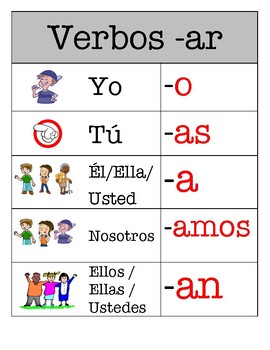
In Spanish, many verbs undergo a stem change when conjugated (in the simple present and past tense). Note that stem-changing verbs are still irregular, but do follow similar patterns, so can be grouped together for context. Let's see a few examples of some of these with their stem changes in the simple present tense. It is difficult to learn these because they do not follow a formula, so they need to be learned and memorized individually. Common Irregular AR Verbs in Spanishīelow, you'll see a list of common irregular AR verbs. So, an irregular verb is a verb that does not follow the standard pattern for conjugation.Ī Spanish irregular verb may have a different ending or stem change than what is normally seen in Spanish verbs, and these changes will affect how the conjugated form of the verb ends and sounds. We learned that a regular verb follows normal, regular endings, whilst an irregular verb does not. What is an Irregular Verb?ĭo you remember that earlier in the article we were discussing regular and irregular verbs? This is not exclusive to AR verbs in Spanish.

If you are learning or planning to use European Spanish or speak Spanish in Europe, then you will need to learn the vosotros form. If you are using Latin American Spanish then you are unlikely to use the vosotros form. With the AR verb hablar, this looks like the below: Remember, in Spanish, there is a formal and informal way to say "you" in the singular and plural forms. Let's take the normal verb hablar to see its form in the simple present tense with each appropriate ending.

Spanish AR Verb Endings in the Simple Present Tense: "You" Using the formula above, try to conjugate these AR verbs by removing the -ar at the end of each word and replacing it with the relevant endings. Here, we list the most common regular and irregular AR verbs in Spanish. Take away these letters and replace them with the relevant endings, which you will find above. We have highlighted the two letters in each verb that will be removed and replaced with the regular verb endings. Try to conjugate them yourself in the present tense (or el presente). Now, take a look at the AR verbs below in their infinitive form. We will use trabajar ("to work") as the example verb:Įllos/ ellas/ ustedes trabaj an Example Verbs Here are the endings for regular AR verbs in Spanish. Once you have learned the regular endings, you will be able to conjugate any regular AR verb in Spanish. Luckily, however, we don't actually need to. Obviously, we cannot cover the conjugations of all AR verbs in Spanish throughout this post.
#Ar verb endings in spanish preterite how to
How to Conjugate AR Verbs in Spanish: 6 Different Endings Now, let's take a look at the most common verbs in Spanish: Mirar Infinitive: CaminarĮllos/ ellas/ ustedes camin an Regular AR verbs in Spanish The conjugations of this verb in the present tense are as follows. The infinitive form of the verb "to walk" ****in the Spanish language is caminar. Note that the ending changes in the third person. Note that in English the conjugation is as follows. Let's take the infinitive of the verb "to walk". When learning a new verb, it's important to learn how to conjugate it in the Spanish present tense, or any tense for that matter. It's very simple.Ī verb conjugation is a set of endings and word changes that signify who is being referred to. If you have not come across the term 'conjugation' before then do not worry. Shortly, we will see what this looks like in practice. The great thing about regular verbs is that once you have learned the correct endings, you will be able to conjugate any other regular verb. An irregular verb, on the other hand, does not follow a normal or regular pattern when conjugated.

How this knowledge benefits you for travel to a Spanish-speaking country.īelieve it or not, understanding regular and irregular verbs is actually relatively straightforward.Ī regular verb is a verb that follows a normal and regular pattern when conjugated.What regular, irregular, and stem-changing verbs are, and why it's important to learn them.What this looks like in practice and how to use these examples to boost your language skills.How AR verbs in Spanish end in various tenses.In the next few minutes, you'll learn the following: Like all verb groups in Spanish, AR verbs follow a specific conjugation pattern, with specific endings in the regular form. In this post, we focus on AR verbs (verbs ending in AR). AR Verbs in Spanish Explained: Endings & Common AR Verbs | 2023Īnybody in the process of learning Spanish should know that there are 3 main verb groups: AR verbs, ER verbs, and IR verbs.


 0 kommentar(er)
0 kommentar(er)
